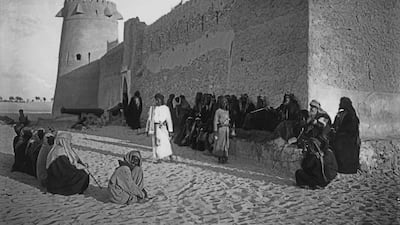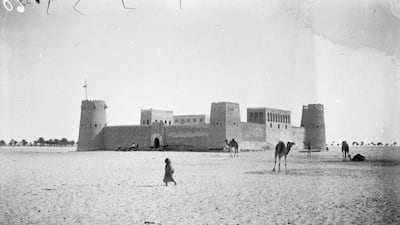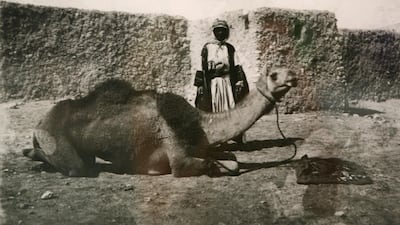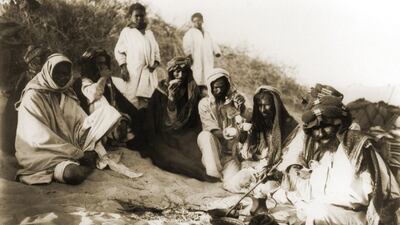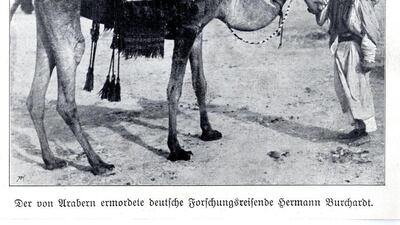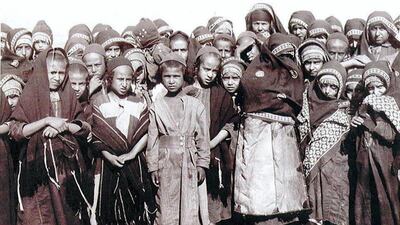It was a mild February day in 1904, and the inhabitants of Abu Dhabi watched, fascinated and baffled in equal measure, at the scene unfolding before them. A man, whose language they did not understand, was assembling an object, the purpose of which seemed equally incomprehensible. It was a large wooden box standing on three legs. After setting it up, the man placed his head under a small curtain that hung from one side. Apparently satisfied, he then dismantled the contraption, only to repeat the process several times over the next few days.
The visitor was Hermann Burchardt, a German explorer who spent much of his adult life living in and exploring the Middle East. In early 1904, at the age of 46, Burchardt arrived in Abu Dhabi as part of an expedition to the Arabian Gulf. He brought with him the most up-to-date camera of the time, though he was not quite the first person to photograph Abu Dhabi.
That honour goes to Samuel Zwemmer, an American missionary who arrived in 1901, and took a photograph of Qasr Al Hosn.
A photograph that's stood the test of time
Burchardt, who brought with him not only a camera and film, but the chemicals and equipment for processing, compiled an entire essay on life in the town. This included a famous photograph that would be familiar to anyone who has ever visited or lived in the UAE: an image of Sheikh Zayed the First, often known as Zayed the Great, which was the first image of a Ruler of Abu Dhabi. He was by then in his seventies and nearing the end of his long reign of 54 years. He sits in his outdoor majlis, under the shade of Qasr Al Hosn, near the main gate. He is dressed in black robes, with a long stick in his right hand, and surrounded by his retinue. A young man stands in front of him carrying a pot of coffee while another in the foreground grins at the camera. A line of men squat on the sand, presumably seeking advice or help.
The image has been reproduced a thousand times, if not more, but it is not the only photograph Burchardt took. There are eight in total, giving a brief snapshot of life 115 years ago.
All of them can now be viewed online, on the new Arabian Gulf Digital Archive, which has been created by the UAE’s National Archive. The originals, on fragile glass plates, are preserved at Berlin’s Museum of Ethnology.
One was not, in fact, taken by Burchardt, as it shows the explorer sat on a camel, wearing native dress and stout boots. He gazes at the camera with confidence.
So who was Hermann Burchardt?
Burchardt came from a wealthy family, and used his inheritance to give up work and travel the world at the age of 30. After teaching himself the basics of several languages, including Arabic and Farsi, he rented an apartment in Damascus, using Syria as a base to explore and photograph the Arab world. In 1901, he travelled to Sanaa, where he was astonished to find a Jewish community. Burchardt, who was of Jewish descent, spent a year in Yemen, capturing the community's life on film for the first time and alerting the world to their existence.
Other journeys took him to Morocco and Samarkand. In December 1903, he left Basra to travel down the Arabian Gulf, taking in Kuwait, Bahrain and Qatar, before reaching Abu Dhabi three months later. His photographs taken in the UAE include fishing boats drawn up on the beach, Qasr Al Hosn taken from afar and a typical palm house, or arish, that was home for most people until well into the 1950s. Two others show the horses from the stables of Sheikh Zayed, including one with a magnificent saddle that may be Rabdan – though is not confirmed – the famous stallion said to be descended from the horse of the Prophet Mohammed and a gift from the sharif of Makkah. There is also a second image of Sheikh Zayed and his entourage, this time closer up.
On his next and final trip to the UAE, four years after his trip to Abu Dhabi, Burchardt returned to Yemen, meeting up with a friend who was the Italian vice-consul in the Red Sea port of Mocha. The city, he wrote in a postcard, was: "One of the most godforsaken little places in Asia. It exceeds all my expectations, with regard to the destruction. It looks like a city entirely destroyed by earthquakes."
With a group of eight people, including the Italian diplomat, Burchardt began crossing over the mountains, heading back to Sanaa. Just before Christmas, and three days from the city, the entourage was ambushed by bandits and killed. The news was widely circulated, reaching as far as Australia, where the Sydney Morning Herald sported the headline: "Explorers Murdered". In Mocha, the European community cancelled Christmas, and flags flew at half-staff.
After his death, Burchardt’s collection of about 2,000 photographic plates was donated to the Berlin museum by a relative. It lay forgotten in the basement, surviving the destruction of the Second World War, only to be rediscovered nearly 20 years ago. A second find, in Jerusalem, of his diaries and papers – and most significantly, a list of pictures – has since allowed scholars to caption and identify almost all of his photos. This, fortuitously, brought us face to face, in 2019, with one of the greatest Rulers of Abu Dhabi.
